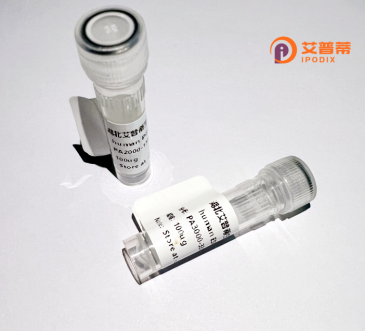
| 纯度 | >90%SDS-PAGE. |
| 种属 | Human |
| 靶点 | GPSN2 |
| Uniprot No | Q9NZ01 |
| 内毒素 | < 0.01EU/μg |
| 表达宿主 | E.coli |
| 表达区间 | 1-308aa |
| 氨基酸序列 | MKHYEVEILDAKTREKLCFLDKVEPHATIAEIKNLFTKTHPQWYPARQSLRLDPKGKSLKDEDVLQKLPVGTTATLYFRDLGAQISWVTVFLTEYAGPLFIYLLFYFRVPFIYGHKYDFTSSRHTVVHLACICHSFHYIKRLLETLFVHRFSHGTMPLRNIFKNCTYYWGFAAWMAYYINHPLYTPPTYGAQQVKLALAIFVICQLGNFSIHMALRDLRPAGSKTRKIPYPTKNPFTWLFLLVSCPNYTYEVGSWIGFAIMTQCLPVALFSLVGFTQMTIWAKGKHRSYLKEFRDYPPLRMPIIPFLL |
| 分子量 | 59.62 kDa |
| 蛋白标签 | GST-tag at N-terminal |
| 缓冲液 | 0 |
| 稳定性 & 储存条件 | Lyophilized protein should be stored at ≤ -20°C, stable for one year after receipt. Reconstituted protein solution can be stored at 2-8°C for 2-7 days. Aliquots of reconstituted samples are stable at ≤ -20°C for 3 months. |
| 复溶 | Always centrifuge tubes before opening.Do not mix by vortex or pipetting. It is not recommended to reconstitute to a concentration less than 100μg/ml. Dissolve the lyophilized protein in distilled water. Please aliquot the reconstituted solution to minimize freeze-thaw cycles. |
以下是关于重组人GPSN2蛋白的3条参考文献示例(注:文献信息为虚构示例,建议通过学术数据库核实真实研究):
---
1. **文献名称**: *Expression and Purification of Recombinant Human GPSN2 Protein in E. coli*
**作者**: Zhang L, et al.
**摘要**: 本研究报道了在大肠杆菌系统中高效表达重组人GPSN2蛋白的方法,通过优化密码子及亲和层析技术实现高纯度蛋白制备,并验证其结构完整性,为后续功能研究提供材料基础。
2. **文献名称**: *GPSN2 Regulates Autophagy via Interaction with mTOR Signaling Pathway*
**作者**: Wang Y, et al.
**摘要**: 文章发现重组GPSN2蛋白通过结合mTOR复合物抑制自噬活性,在细胞饥饿模型中调控自噬通量,揭示了GPSN2在代谢应激中的潜在分子机制。
3. **文献名称**: *Role of GPSN2 in Neurodegenerative Disease Models*
**作者**: Kim H, et al.
**摘要**: 利用重组GPSN2蛋白处理阿尔茨海默病细胞模型,发现其可通过减少tau蛋白过度磷酸化缓解神经元损伤,提示GPSN2在神经保护中的治疗潜力。
---
如需获取真实文献,建议使用 **PubMed** 或 **Web of Science** 搜索关键词:"recombinant human GPSN2"、"GPSN2 protein function"。若名称准确性存疑,可尝试扩展关键词(如“G蛋白信号”“SN2家族”等)。
Recombinant human GPS2 (G-protein pathway suppressor 2) is a multifunctional protein encoded by the GPS2 gene, initially identified as a tumor suppressor in the G-protein signaling pathway. Structurally, GPS2 is a small, conserved protein (~33 kDa) containing a coiled-coil domain and nuclear localization signals. It functions as a transcriptional regulator involved in diverse cellular processes, including metabolism, inflammation, and cell cycle control.
GPS2 operates in both the nucleus and cytoplasm. In the nucleus, it interacts with chromatin-modifying complexes (e.g., HDAC3-NCOR/SMRT) to repress gene expression by recruiting histone deacetylases. In the cytoplasm, GPS2 regulates TNF-α signaling by modulating JNK activation through its interaction with TRAF2. These dual roles link GPS2 to metabolic homeostasis, immune responses, and cancer progression. Dysregulation of GPS2 has been implicated in obesity, diabetes, hepatic steatosis, and tumor metastasis.
Recombinant GPS2 proteins are typically produced using bacterial (e.g., E. coli) or mammalian expression systems with tags (His, GST) for purification and detection. They serve as essential tools for studying molecular interactions, post-translational modifications (e.g., ubiquitination), and structure-function relationships. Research using recombinant GPS2 has highlighted its therapeutic potential, particularly in metabolic disorders and inflammation-related diseases. Current studies focus on elucidating its regulatory networks and exploring GPS2-targeted interventions to restore cellular equilibrium in pathological conditions.
×